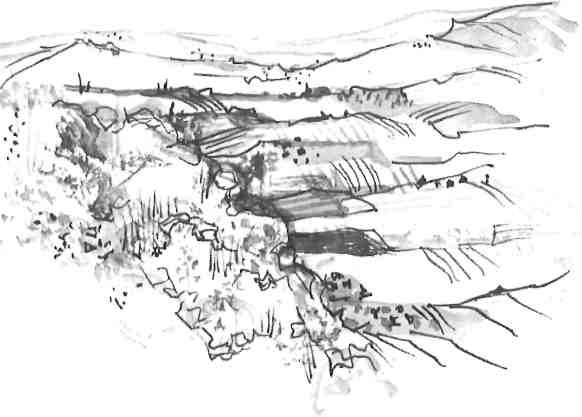The way this little fib got started is that, archaeologically speaking, there are comparatively few ruins remaining from the ancient city of Sparta.

Well and good. Thucydides predicted that future ages would find this to be so, for Sparta trusted in her living reputation, rather than in high-piled stones.
That reputation still lives. Although no glorious Parthenon testifies to Sparta’s unique civilization, the traveller gazes in wonder on the vast green plain of Laconia, flanked by the Taygetus range, a mountain which, in a land endowed with magnificent mountains, can only be described as imperial. On its slopes the ancient Spartans exposed their weak and sickly infants.
If you are a little weary of crumbling stones, however glorious, a weekend in the homeland of Lycurgus will have the effect of a true Spartan tonic.
In Laconia all roads lead to Sparta which is thronged with comfortable hotels, innumerable restaurants and shops, and two movie houses, where the feature films in every language under the sun change three times a week.
A favourite relaxation for both Spartans and visitors is to sit amid orange trees in the well-padded mchairs of the Brasilia kafeneion where, with a cool drink in hand, one may gaze dreamily across a dazzling white square to the great bronze-purple walls of Taygetus, only six kilometers away. Mornings and evenings, a soothing blend of concert and the more pleasant kind of popular European music softly streams from microphones concealed in the orange trees. The absence of commerical jangle and traffic noise make this custom an extraordinarily refreshing experience.
The fragmentary ruins of ancient Sparta lie on the north flank of the modern town, guarded by a fine bronze statue of King Leonidas, the hero of Thermopylae. The statue was donated to the city in 1968 by a Laconian citizen, Panos Koumantaros.
Mistras, a ten minute drive from Sparta, is of course the main tourist attraction. If you are not already caught up in the fabulous splendours of the Byzantine culture, a visit to this lofty cone-shaped hill at the foot of Taygetus, with its mass of medieval palaces, churches and monasteries, could ignite a whole new passion to be pursued at leisure.
After climbing the slopes of Mistras in the hot sun, nothing from the past could be more appealing than refreshment at a beautiful Xenia restaurant, located just below the ruins in a garden of flowering shrubs and roses. The view over the valley from the Xenia’s dining terrace is breathtaking and to linger there over an excellent dinner and drinks gives one some inkling of the headiness experienced by those feudal overlords who ruled from an Olympus-like summit over a world seen moving in miniature far below.
Farther down the slope is another fine restaurant, the ‘Mamara’, and in the village of Mistras at the bottom of the hill are several little kafeneions and a small hotel with a restaurant where good steaks and chops are always available.
A few minutes along the road at the foot of the mountain is Parori of the waterfalls—truly a wayfarer’s delight. Here, under the cathedral-like shade of giant plane trees several hundred years old, you may while away whole afternoons listening to the mountain music of tumbling waters, writing those long overdue postcards and letters, or just enjoying the lazy tranquility and the delightful personalities of the inhabitants. After dark, Parori takes on an air of pure enchantment; induced by a combination of natural poetic attributes. The village is wedged against the very base of Taygetus, and down the hard rock surface which forms a circling wall along one entire side of the leafy square pour a dozen mountain torrents, some converging in the old stone fountain which must have been there forever, to judge by the ancient designs on the blocks.
Out of the deep, enfolding dark of the countryside, ribbons of gleaming lights, laughter, and music draw you irresistibly toward the clusters of tables and chairs thronged with festive Spartiates and happily bemused travellers.
Three cafe-tavernas compete for your favour, offering aromatic banquets of delicious steaks, barbecues, salads and seasonal dishes. But the competition is friendly and co-operative. The various proprietors may be seen dashing into each other’s establishments at the height of activities to borrow some item temporarily wanting at home base.
These are some of the things there are to see in Sparta and her environs, but there is a good deal more.







